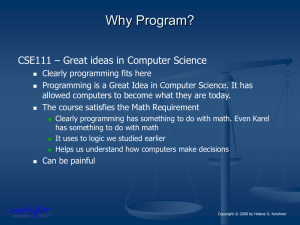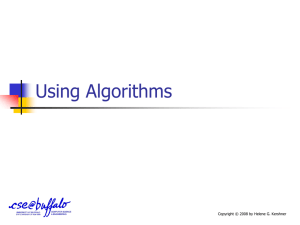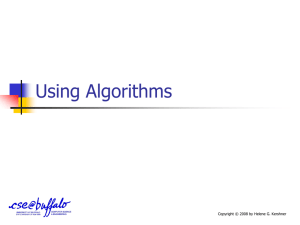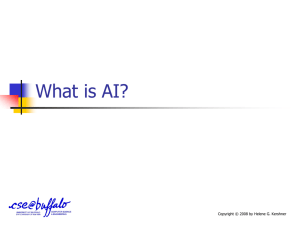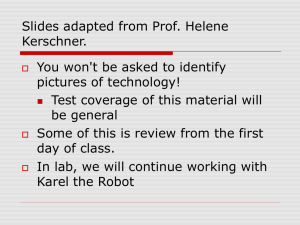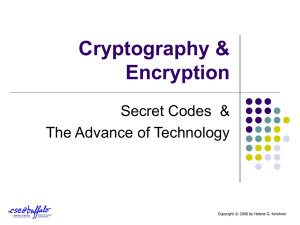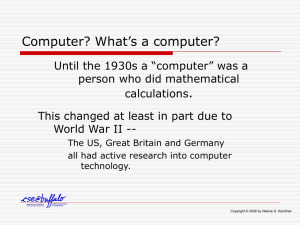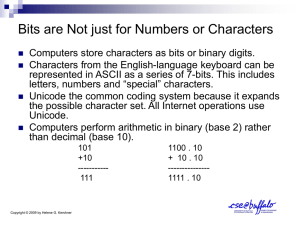Free Software
advertisement
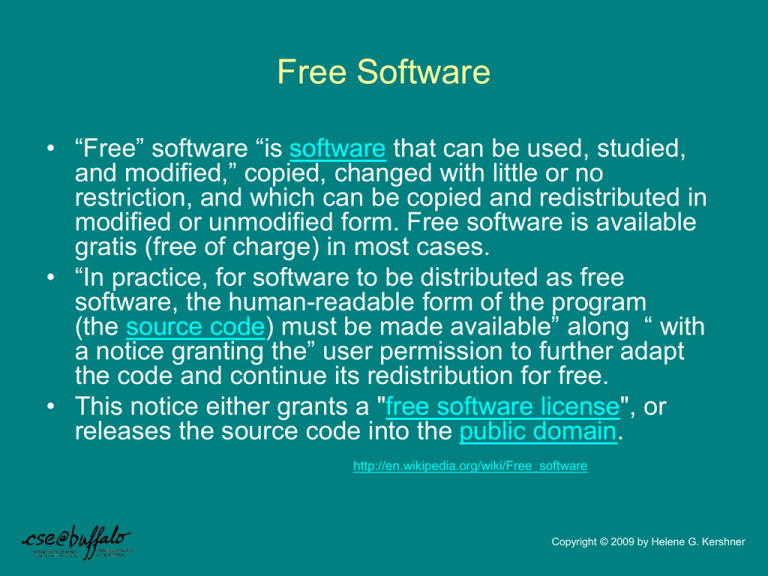
Free Software • “Free” software “is software that can be used, studied, and modified,” copied, changed with little or no restriction, and which can be copied and redistributed in modified or unmodified form. Free software is available gratis (free of charge) in most cases. • “In practice, for software to be distributed as free software, the human-readable form of the program (the source code) must be made available” along “ with a notice granting the” user permission to further adapt the code and continue its redistribution for free. • This notice either grants a "free software license", or releases the source code into the public domain. http://en.wikipedia.org/wiki/Free_software Copyright © 2009 by Helene G. Kershner Open Source Software • In the beginning, all software was free – in the 1960s ,when IBM and others sold the first large-scale computers, these machines came with software which was free. – This software could be freely shared among users, • The software came written in a programming language (source code available), and it could be improved and modified. • Manufacturers were happy that people were writing software that made their machines useful. (1) • Then proprietary software dominated the software landscape as manufacturers removed access to the source code. – IBM and others realized that most users couldn’t or didn’t want to “fix” their own software and – There was money to be made in leasing or licensing software. Adapted from http://eu.conecta.it/paper/brief_history_open_source.html (1)http://en.wikipedia.org/wiki/Free_software Copyright © 2009 by Helene G. Kershner Open Source Software • By the mid-1970s almost all software was proprietary • “Proprietary software is software that is owned by an individual or a company (usually the one that developed it). There are almost always major restrictions on its use, and its source code is almost always kept secret.” users were not allowed to redistribute it, (1) – – – – source code is not available users cannot modify the programs. Software is an additional product that was for sale In 1980 US copyright law was modified to include software (1) Adapted from http://eu.conecta.it/paper/brief_history_open_source.html (1) http://en.wikipedia.org/wiki/Free_software Copyright © 2009 by Helene G. Kershner Open Source Software • In late 1970s and early 1980s, two different groups started what became known as the open source software movement: • East coast, Richard Stallman (1985), formerly a programmer at the MIT AI Lab, launched the GNU Project and the Free Software Foundation. – “to satisfy the need for and give the benefit of ‘software freedom’ to computer users.” (1) – ultimate goal of the GNU Project was to build a free operating system – the GNU General Public License (GPL) was designed to ensure that the software produced by GNU will remain free, and to promote the production of more and more free software. Adapted from http://eu.conecta.it/paper/brief_history_open_source.html (1) http://en.wikipedia.org/wiki/Free_software Copyright © 2009 by Helene G. Kershner Free Software Foundation Guiding Principles • “Free software is a matter of liberty, not price. • To understand the concept, you should think of free as in free speech (right), not as in free beer (gift). • Free software is a matter of the users' freedom to run, copy, distribute, study, change and improve the software. – The freedom to run the program, for any purpose (freedom 0). – The freedom to study how the program works, and adapt it to your needs (freedom 1). Access to the source code is a precondition for this. – The freedom to redistribute copies so you can help your neighbor (freedom 2). – The freedom to improve the program, and release your improvements (and modified versions in general) to the public, so that the whole community benefits (freedom 3). Access to the source code is a precondition for this.” http://www.gnu.org/philosophy/free-sw.html Copyright © 2009 by Helene G. Kershner Free Software Foundation Guiding Principles • “A program is free software if users have all of these freedoms. Thus, you should be free to redistribute copies, either with or without modifications, either gratis or charging a fee for distribution, to anyone anywhere. Being free to do these things means (among other things) that you do not have to ask or pay for permission. • You should also have the freedom to make modifications and use them privately in your own work or play, without even mentioning that they exist. If you do publish your changes, you should not be required to notify anyone in particular, or in any particular way.” http://www.gnu.org/philosophy/free-sw.html • This is a philosophy, a world view. Copyright © 2009 by Helene G. Kershner Free Software Foundation • Very counter-culture • Hacker is considered a “good-guy” – “Hacker (computer security) someone involved in computer security/insecurity – Hacker (programmer subculture), a programmer subculture originating in the US academia in the 1960s, which is nowadays mainly notable for the free software/open source movement – Hacker (hobbyist), an enthusiastic home computer hobbyist” http://en.wikipedia.org/wiki/Hacker • Cracker is a “bad-guy” – A cracker is someone who cracks software or digital media – “Software cracking is the modification of software to remove protection methods: copy protections, trial/demo version, serial number, hardware key, date checks, CD check or software annoyances like nag screens and adware”. http://en.wikipedia.org/wiki/Cracker_(computing) Copyright © 2009 by Helene G. Kershner Open Source Software • West coast, the Computer Science Research Group (CSRG) of the University of California at Berkeley was improving the Unix system, and building applications which quickly become “BSD Unix”. • Unix was initially developed by AT&T employees (1) – efforts were funded mainly by DARPA contracts – a network of Unix programmers around the world helped to debug, maintain and improve the system. – in late 1980s, distributed under the ``BSD license'' (one of the first open source licenses). – Unfortunately, still contained some components that were proprietary requiring a license from AT&T Adapted from http://eu.conecta.it/paper/brief_history_open_source.html (1)http://en.wikipedia.org/wiki/UNIX Copyright © 2008 by Helene G. Kershner Open Source Software • During the 1980s and early 1990s, open source software continued its development, initially in several relatively isolated groups. • Slowly, much of the software was integrated • The various groups merged • As a result of this, complete operating environments could be built on top of Unix using open source software. • Many Internet ISPs use UNIX as their operating system of choice. Adapted from http://eu.conecta.it/paper/brief_history_open_source.html Copyright © 2008 by Helene G. Kershner Open Source Software • 1991-1992, the open source world improved • In California, Bill Jolitz implementing a version of BSD Unix free of AT & T’s copyright. – The work was covered by the BSD license making it completely free. – It included other free software GNU licenses Adapted from http://eu.conecta.it/paper/brief_history_open_source.html Copyright © 2008 by Helene G. Kershner Open Source Software • Also during 1991-1992 • In Finland, Linus Torvalds, a Finnish computer science student, was implementing the first versions of Linux. • Other people joined to collaboration to create the GNU/Linux operating system. • By 1993, both GNU/Linux and BSD Unix were free stable operating environments. – Both continue to evolve Adapted from http://eu.conecta.it/paper/brief_history_open_source.html Copyright © 2008 by Helene G. Kershner Open Source Software • “Open source is a development method for software that harnesses the power of distributed peer review and transparency of process. • The promise of open source is better quality, higher reliability, more flexibility, lower cost, and an end to predatory vendor lock-in. • The Open Source Initiative (OSI) is a non-profit corporation formed to educate about and advocate for the benefits of open source.” • OSI includes a standards body, maintaining the Open Source Definition for the good of the community. http://www.opensource.org/ Copyright © 2008 by Helene G. Kershner Open Source Software • Today there are many who believe proprietary software is the only possible model – Microsoft – Apple, especially for the iPod and iPhone • Recently the software industry has begun to considered free software as an option again. – Apple’s OS X and Leopard are based on Unix – Google’s Chrome – Mozilla Firefox Copyright © 2009 by Helene G. Kershner Open Source vs Proprietary Software Why choose proprietary software over open source? Survey says!by Matt Asay http://news.cnet.com/8301-13505_3-9789275-16.html Open Source vs Proprietary Software Why choose proprietary software over open source? Survey says!by Matt Asay http://news.cnet.com/8301-13505_3-9789275-16.html Open Source Software See for Yourself Revolution OS • “Revolution OS is a 2001 documentary which traces the history of GNU, Linux, and the open source and free software movements. “ http://video.google.ca/videoplay?docid=7707585592627775409 • Richard Stallman & Opensource http://www.youtube.com/watch?v=kSZZraHN0Yg&feature=PlayList& p=65CA10D0F42E48FD&playnext=1&playnext_from=PL&index=7 • Free software CNet http://www.youtube.com/watch?v=a9fqlI9B6QU&feature=PlayList&p =65CA10D0F42E48FD&playnext=1&playnext_from=PL&index=9 • Linux -- IBM http://www.youtube.com/watch?v=KwEWxpOWOok • Linux commercials http://www.youtube.com/watch?v=aufL76bXLAg&feature=related Copyright © 2009 by Helene G. Kershner

